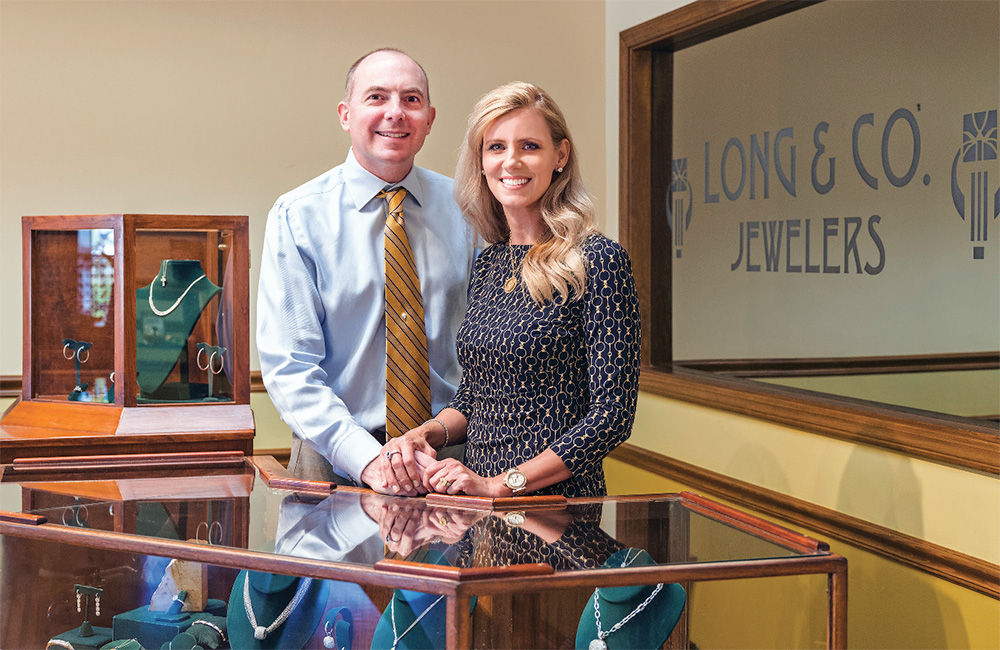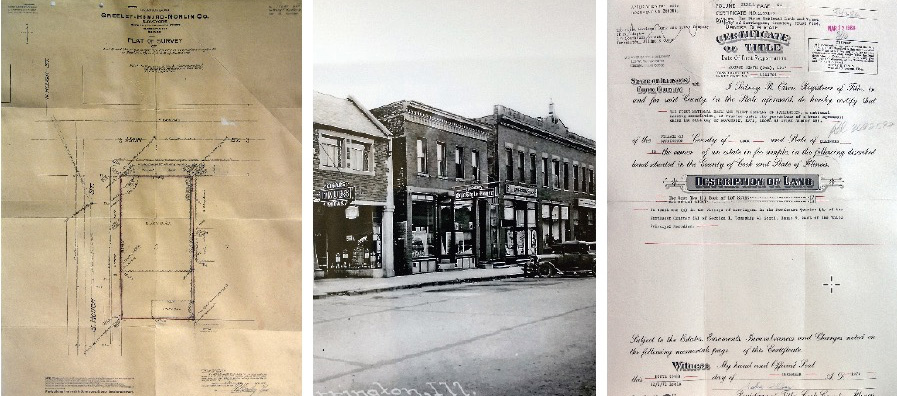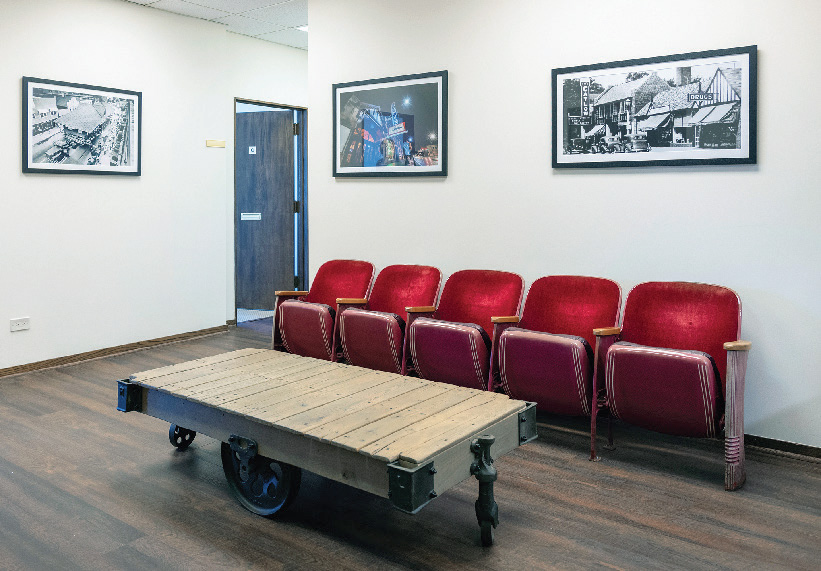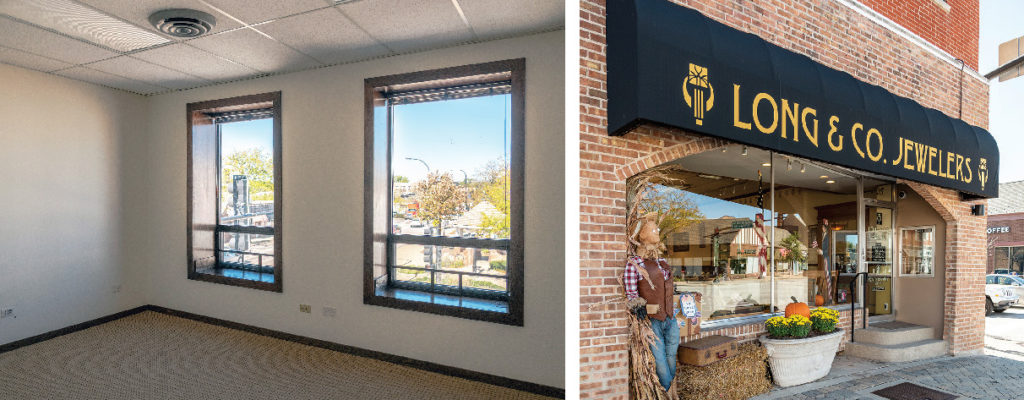

On March 20, 2020, one of Barrington’s most iconic buildings, rich in history, changed hands. Julianne and Brian Long of Long & Co. Jewelers purchased the building at 101 S. Hough Street from the Gallagher family who had owned it for 49 years. “It was a surreal week leading up to the Friday closing.” Long said. “Restaurants were being ordered to close and people were being asked to shelter in place due to COVID-19. Until day of, we weren’t even sure our closing would take place! But everything went through just in the nick of time, and we knew it was meant to be.”
In addition to its three Main Street storefronts, the upper level is masterfully designed for modern day offices. The spacious hallways commemorate the history of downtown Barrington with framed historic photographs as well as a row of original seats from the Catlow Theater. “We currently have available offices with hands down the best views of historic Main Street,” says Long. “I’ve had people up there who have lived in Barrington their whole lives, and they can’t believe the views!” The Longs have updated the shared amenities, and offices for lease have new carpet and paint. You can find information on renting the offices under ‘available properties’ on The Village of Barrington website at www.barrington-il.gov.
Brian Long, who brought his jewelry skills to Barrington in 2001, enjoyed frequenting the Catlow Theater in his youth. He appreciated the small-town environment of Main Street. When the owner of Michal’s Jewelers, the successor to Wenzels, retired in 2006, he was ready to take over as the building’s resident jeweler. With great respect for the historic building that housed his store, Long naturally became the go-to guy for coordinating on-site building upkeep. Long & Co. Jewelers thrives on this cornerstone of Barrington.
Few towns now, like Barrington, tell so well the story of their decades through the diversity of the architecture along their Main Streets. For 155 years, Barrington’s main streetscape has preserved the past, and stayed in step with changing times. From frame storefronts that were once livery stables and wagon repair shops, to typical brick buildings of the late-19th century that replaced those destroyed in downtown fires; to the Tudor styles that emerged along main streets between the World Wars; to post- World War II utilitarian buildings that filled in the lots, empty from the torn down old structures.
In the 1980s came the enlightenment of historic preservation, as a National Register Historic District took in much of the old business center. It affirmed that Barrington’s Main Street is a story of settlers, of families, of merchants, and neighbors; the steely backbone of pioneers from which the little town prospered and grew.

Of the late-19th century brick commercial buildings, there is one standout today; that is the brick and stone building at the southeast corner of Hough and Main Streets. Known for years to older residents as the Gallagher Building, and now owned by Julianne and Brian Long of Long & Co. Jewelers, it dates from 1893. The builder was Garret Lageschulte, whose family would become established among the town’s merchants and builders, and whose descendants still live in the Barrington area.
Before Lageschulte constructed his two-story statement of the town’s growing prosperity, it challenges our imagination to recall what that corner looked like, except that we have the reminiscences of the very old timers, as given to Barrington’s foremost historian of those years, Arnett C. Lines.
Sitting today, enjoying your coffee at Starbucks, close your eyes and take a moment to think about those earlier times, when Main Street going west was but a dusty wagon road to the farms, with a few newer homes on large rural lots, and when Hough Street, then called William Street, was also a rugged road, south to the Dundee and Algonquin stage and mail routes. This corner of Hough and Main was a picturesque and somewhat ramshackle end of the incorporated village. Property lines and rights of way were haphazardly observed. Ordinances were mainly concerned with containing runaway livestock, especially the occasional wandering pig or cow.
For instance, William Howarth’s house was approximately where you are sitting. It was surrounded by a white picket fence, and his barn stood south of his house, with his lot extending to Station Street, which did not exist then. In spite of warnings from the Village Board, he kept a fence across Main and Hough, leaving only a narrow passage for the few north and southbound travelers. Thus, Hough Street was his barnyard. There were many similar residences and barnyards near the center of town, and had Egg Harbor existed then, eggs could have been freshly gathered every morning!
Across the street on the east side, north from East Station Street to Main Street, picket fences, also overlapping the right of way, defined several lots. At the Station Street corner, Leopold Krahn, who had been a cavalry officer in the Civil War, built his house, and attached north of it one for his mother, who was known as the Widow Kortzhalz. His business was painting, conducted from a barn, also near the street. Further north from there, to the corner, another small lot and house belonged to Mrs. Willmer, with flowers planted inside its fence. Each building had its own dug well and outhouse. Halloween pranks were said to have included tipping them over! The prevailing street conditions were either mud or dust, and it should also be remembered, horses often outnumbered pedestrians. Streets were lined with hitching posts.
But your coffee is finished, and we’ll move on! Since its founding in 1854, Barrington has had reliable train service to the city, and that service allowed Barrington residents to go in droves to the 1893 Chicago World’s Fair, at the shimmering White City. They began to see the future in engineering, in architecture, in food, and in fashion. But even before the Fair dazzled the world, fires in Barrington had begun to propel the forces of change. Instead of those flammable frame buildings, bricks became the construction material of choice.

Garret Lageschulte’s building did not come about by fire. Instead, he acquired three lots along the south side of Main Street, and, in an already familiar Barrington sight, moved the three buildings from there to other locations in Barrington. First, Mrs. Willmer’s house at the corner was moved to Spring and Lincoln Streets; next east, Grandma Thies’s residence was moved to East Lincoln, and east of Grandma Thies, Charles Jahnke’s building was moved to 615 South Hough Street, where it became the residence of Ed Jencks. They were early examples for the Barrington tradition of repurposing buildings.
Lageschulte’s building was imposing by the local standards of the day. At street level were three store fronts; a multi-use second floor where businesses such as milliners or dressmakers could conduct business out of living quarters. What distinguished this building was the high brick and stone cornice which gave it the appearance of being three stories. In the center of this cornice was a high tower-like structure. This was removed during later renovations, and there is no clear photograph of it.
The first main tenant, whose name resonates today, was Grebe’s Hardware Store. Harold Grebe’s store on Park Avenue had burned a year earlier, and now, for the next 18 years he occupied the east section of the Lageschulte Building, and then returning to Park Avenue, where the business, taken over by his son Kenneth Grebe, remained until 1978.
In the early years, according to Arnett C. Lines, other tenants included Waller’s Drug Store, and William J. Cameron’s Drug Store. When Grebe left, his section was occupied by Mark Babcock’s Bowling Alley. Henry Butzow’s bakery, confectionary and ice cream parlor was another popular tenant and later the Public Service Company used the center section. Their advertising is prominent in the pages of the old Barrington Reviews.
In 1898 the village was coming on-line with gas and water mains, electricity, and the telephone. The Hough and Main Street intersection had been improved and the rights of way enforced. Still, in the mid-1920s, the Lageschulte Building and the A.W. Meyer General Store facing it across the street, remained as bookends to the business district. In 1924, several of the residences occupying the north side of West Main Street were moved west, clearing the way for the construction of the Catlow Theater. The street was finally paved and the cattle drives to the holding pens by the railroad ceased. Photographs of the time show a busy downtown with automobiles filling the parking spaces, punctuated with a few horses and wagons still rolling in from the village’s rural surroundings. Hitching posts remained for their use.
Hough Street/Route 59 became a busy north-south artery, and William Howarth’s house was moved to 316 West Main Street. Eventually the Pure Oil Company occupied that corner. But it was still an easy-going, walkable town. Groceries, dry goods, confectionary, bakery, meat and fish markets, and the hardware store all were within two or three blocks of each other. Doctors’ offices too occupied some second-floor rooms. After the Second World War, luxury shopping catered to the area’s growing affluence. When Mary Gallagher purchased the Lageschulte Building in 1971, the principal tenant was Wenzel’s Jewelers. With their elegant selection of jewelry, silverware, and crystal, many a celebratory occasion was commemorated with a purchase at Wenzel’s, who occupied the left of the three store fronts.
The Gallaghers did much to maintain the building and keep it viable. They added brick arches to the entire Main Street and Hough Street first story façades to shield the building’s entrances and windows. The stone lintels were preserved over the second-floor windows, and while the high cornice and the “mysterious” center ornament were removed, an appropriate stone cornice now stretches along the top of the building. The entire appearance is one of harmony in the evolving streetscape. Mary Gallagher held a vital role in preserving this Barrington icon when in the early 2000s she declined an offer to sell it to the developers of Cook Street Plaza. Had she sold her building at that time, it wouldn’t be here today.
Now you know the story. Enjoy another cup of coffee, look around you from the best vantage point in town, and take in 155 years of history, from dusty barnyards to dazzling diamonds. It is a very good story, and Brian and Julianne of Long & Co. Jewelers have the crystal Champagne flutes to raise a toast to those pioneers who went before us.
Long & Co. Jewelers is located at 105 E. Main Street in downtown Barrington. To learn more, visit long-and-co.com.
Barbara L. Benson grew up in Kent, England, and later moved to New York. She settled in Barrington and has walked with our history since she first arrived here in 1980.
Share this Story